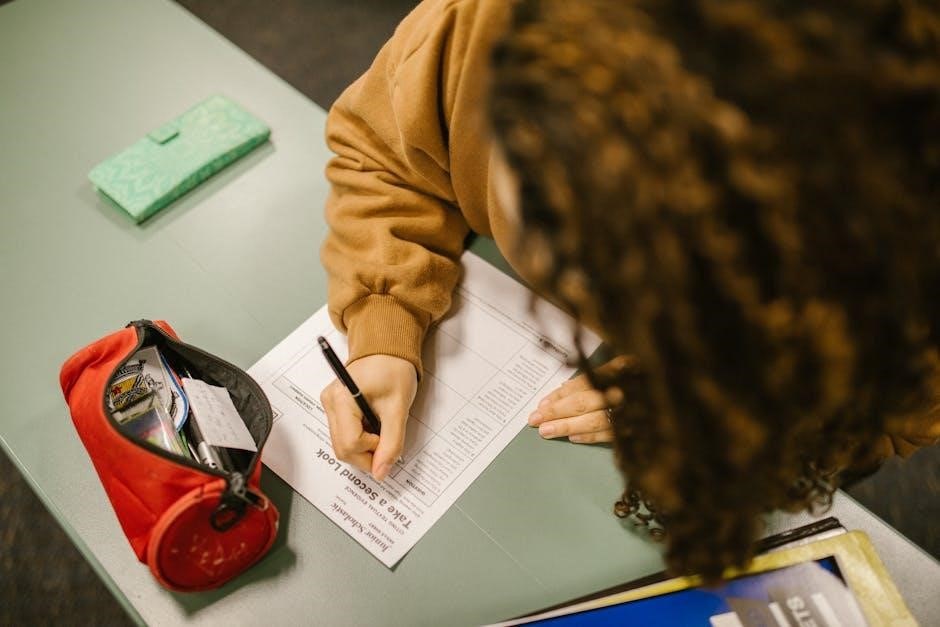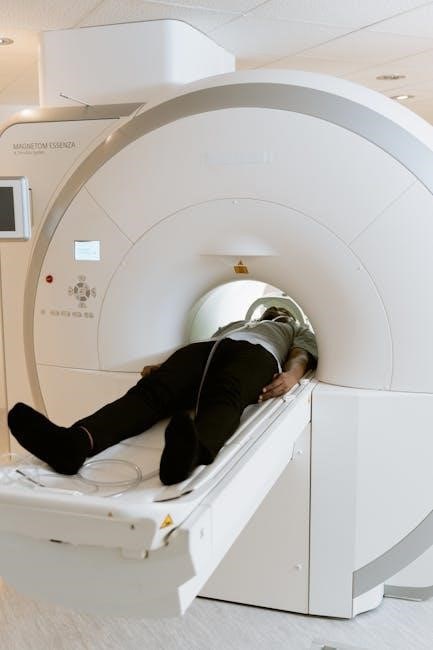ablls assessment pdf
The ABLLS-R is a comprehensive assessment tool for evaluating language and learning skills in individuals with autism or developmental disabilities, created by James Partington and Mark Sundberg.
1.1 Overview of the ABLLS-R
The ABLLS-R (Assessment of Basic Language and Learning Skills-Revised) is a criterion-referenced assessment tool designed to evaluate the language, academic, self-help, and motor skills of individuals with autism or other developmental disabilities. It serves as a comprehensive guide for identifying skill levels, tracking progress, and developing personalized educational programs. Created by James W. Partington and Mark Sundberg, the ABLLS-R is widely used in educational and clinical settings to support learners with diverse needs. The assessment is individually administered and covers a broad range of skills, making it a valuable resource for educators, therapists, and caregivers. Its structured protocol and accompanying guide provide clear instructions for administration, scoring, and interpreting results, ensuring effective goal setting and intervention planning.
1.2 Importance of the ABLLS-R in Assessing Skills
The ABLLS-R plays a crucial role in assessing the foundational skills of individuals with autism or developmental disabilities, providing a clear framework for identifying strengths and areas needing support. Its comprehensive approach ensures that language, academic, self-help, and motor skills are evaluated systematically. By pinpointing specific skill levels, the ABLLS-R aids in creating targeted and measurable goals for individualized education programs (IEPs). This tool is invaluable for educators and therapists, as it offers a consistent and reliable method for tracking progress over time. The assessment’s criterion-referenced design ensures that skills are measured against developmental milestones, making it a cornerstone in special education and therapeutic interventions.

History and Development of the ABLLS-R
The ABLLS-R was developed by James W. Partington and Mark Sundberg, evolving from the original ABLLS to provide a more refined and comprehensive assessment tool for developmental skills.
2.1 Creation by James W. Partington and Mark Sundberg
The ABLLS-R was created by Dr. James W. Partington, Ph.D., BCBA-D, and Mark Sundberg, prominent figures in the field of behavior analysis and autism intervention. Initially developed in 1994, the assessment was designed to evaluate the language, academic, self-help, and motor skills of children with autism or developmental disabilities. The tool combines an assessment protocol with a curriculum guide and skills tracking system, making it a comprehensive resource for educators and clinicians. The ABLLS-R Protocol and its accompanying guide provide detailed instructions for administration, scoring, and interpreting results, as well as strategies for developing Individualized Education Program (IEP) goals. This collaborative effort has made the ABLLS-R a cornerstone in special education and behavioral assessment practices.
2.2 Evolution from the Original ABLLS to ABLLS-R
The ABLLS-R is a revised version of the original Assessment of Basic Language and Learning Skills (ABLLS), developed to address the growing need for a more comprehensive and user-friendly tool. The original ABLLS, created in 1994, laid the foundation for assessing language and learning skills in children with autism and developmental disabilities. Over time, feedback from educators and clinicians led to the development of the ABLLS-R, which expanded skill categories, improved the scoring system, and introduced a more detailed guide for administrators. The revised version also incorporated a skills tracking system, enabling better progress monitoring. These updates enhanced the tool’s effectiveness in identifying learning needs and guiding individualized instruction, solidifying its role in special education and behavioral assessment practices.
2;3 Revisions and Updates in the ABLLS-R Protocol
The ABLLS-R Protocol has undergone significant revisions to enhance its effectiveness as a diagnostic and educational tool. Updates include the addition of a detailed skills tracking system, allowing for more precise monitoring of progress over time. The revised protocol also features an expanded guide that provides clearer instructions for administrators, ensuring consistency in assessment practices. Furthermore, the inclusion of digital tools, such as WebABLLS, has streamlined the process of data collection and reporting. These updates reflect advancements in understanding developmental disabilities and the need for adaptable, comprehensive assessment methods. The revisions aim to improve the accuracy of skill evaluations and support personalized learning strategies for individuals with autism or other developmental challenges.

Structure of the ABLLS-R Assessment
The ABLLS-R Assessment is organized into core skill areas, including language, academic, self-help, and motor skills. It combines a detailed protocol, guide, and tracking system for comprehensive evaluation.
3.1 Core Skill Areas Assessed
The ABLLS-R Assessment evaluates four primary skill areas: language, academic, self-help, and motor skills. These areas are further divided into subcategories to ensure a thorough evaluation. The language section assesses both receptive and expressive skills, such as verbal imitation, receptive identification, and intraverbals. Academic skills focus on foundational abilities like matching, sorting, and basic math. Self-help skills include daily living tasks such as eating, dressing, and personal hygiene. Motor skills cover fine and gross motor abilities, such as drawing, cutting, and physical coordination. This comprehensive approach ensures a detailed understanding of an individual’s strengths and needs, aiding in the development of tailored educational plans and goals.
3.2 The ABLLS-R Protocol and Its Components
The ABLLS-R Protocol is a structured framework designed to systematically assess and track the skills of individuals with autism or developmental disabilities. It includes a comprehensive set of assessment items organized into specific skill areas. The protocol comprises detailed scoring instructions to ensure consistency and accuracy in evaluation. Additional components include the ABLLS-R Guide, which offersguidance on administration, scoring, and interpreting results. Supplementary resources, such as tracking sheets and digital tools like WebABLLS, enhance the assessment process by providing efficient ways to monitor progress and generate reports. These components collectively support educators and professionals in creating personalized learning plans tailored to individual needs.
3.3 The Role of the ABLLS-R Guide
The ABLLS-R Guide serves as an essential companion to the ABLLS-R Protocol, providing detailed instructions and resources for effective assessment and curriculum development. It outlines the proper methods for scoring assessment items, ensuring accuracy and consistency. Additionally, the guide offers a framework for developing Individualized Education Program (IEP) goals and objectives, tailored to address the specific needs of each student. The guide also includes strategies for instructional planning and curriculum implementation, making it a valuable tool for educators and professionals. By offering clear guidelines and practical applications, the ABLLS-R Guide supports the creation of personalized learning plans, fostering meaningful progress for individuals with autism or developmental disabilities.
3.4 Skills Tracking System
The ABLLS-R Skills Tracking System is a robust tool designed to monitor progress in skill development over time. It provides a structured format for documenting achievements and identifying areas requiring additional support. The system includes tracking sheets available in both PDF and editable formats, allowing users to easily record and update student performance. These sheets correspond to the skills assessed in the ABLLS-R Protocol, ensuring consistency and accuracy. Additionally, digital tools like WebABLLS offer advanced tracking features, generating personalized PDF reports that include the student’s name and specific skill data. This system is invaluable for educators and professionals, enabling them to track progress, set goals, and make informed decisions about instruction and intervention.

Administration of the ABLLS-R
The ABLLS-R administration involves a systematic process of evaluating skills through specific protocols and guidelines, utilizing tracking sheets and digital tools like WebABLLS for accurate assessment.
4.1 Process of Administering the Assessment
The ABLLS-R assessment is an individually administered, criterion-referenced evaluation designed to measure language, academic, self-help, and motor skills in individuals with autism or developmental disabilities. The process begins with preparing the necessary materials, including the ABLLS-R Protocol and tracking sheets. Administrators, typically trained professionals, guide the individual through a series of tasks aligned with specific skill areas. Each item is scored based on the individual’s ability to perform the task independently or with assistance. The assessment is conducted in a structured yet flexible manner, allowing for adjustments to ensure the individual’s comfort and engagement. Results are recorded on tracking sheets, which can later be used to monitor progress and develop targeted goals. Digital tools, such as WebABLLS, may also be utilized to streamline the administration process and enhance accuracy.
4.2 Preparing for the ABLLS-R Administration
Preparing for the ABLLS-R administration involves gathering all necessary materials, including the ABLLS-R Protocol, tracking sheets, and any additional resources like WH Questions Cards or Emotional Regulation tools. Reviewing the ABLLS-R Guide is essential to understand scoring instructions and ensure accurate assessment. Administrators must familiarize themselves with the skill areas and tasks to present them clearly. Organizing a quiet, distraction-free environment is crucial to ensure the individual’s focus. Ensuring the individual is comfortable and ready for the assessment is also key. Digital tools like WebABLLS can streamline preparation by providing editable tracking sheets and personalized assessment materials. Proper preparation ensures the assessment is conducted efficiently and effectively, leading to reliable results.
4.3 Requirements for Administrators
Administrators of the ABLLS-R must meet specific requirements to ensure accurate and effective assessment. They should hold relevant certifications, such as BCBA (Board Certified Behavior Analyst), and possess experience in applied behavior analysis (ABA). A strong understanding of the ABLLS-R Protocol and Guide is essential, as well as familiarity with the skills assessed. Administrators must demonstrate patience, clear communication, and the ability to engage individuals with diverse needs. They should also be skilled in observing and recording behaviors accurately. Additionally, administrators are encouraged to complete training or workshops on the ABLLS-R to stay updated on best practices. Adherence to the assessment protocol and ethical guidelines is paramount to ensure reliable results and respect for the individual being assessed.

Scoring and Interpretation of ABLLS-R Results
The ABLLS-R scoring system involves evaluating each item based on specific criteria, with results interpreted to track progress and guide educational planning.
5.1 How to Score ABLLS-R Items
Scoring ABLLS-R items involves systematically evaluating each skill based on predefined criteria. The ABLLS-R Guide provides detailed instructions for accurate scoring, ensuring consistency across administrators. Each item is scored as mastered, emerging, or un-mastered, reflecting the individual’s proficiency level. Administrators must carefully observe responses and compare them to the criteria outlined in the protocol. The scoring process is supported by tracking sheets, which help document progress over time. Correct scoring is essential for generating reliable results, which inform educational planning and goal development. The ABLLS-R scoring system emphasizes clarity and objectivity, ensuring that assessments accurately reflect an individual’s skills and needs.
5.2 Interpreting Assessment Results
Interpreting ABLLS-R results involves analyzing the scored items to identify an individual’s strengths, weaknesses, and skill gaps. The ABLLS-R Guide provides clear guidelines for interpreting data, ensuring accurate and meaningful outcomes. Results are categorized into skill levels, offering a detailed profile of the individual’s abilities. This profile informs the development of targeted IEP goals and educational strategies. By understanding the results, educators can prioritize skills that need development while reinforcing existing strengths. The interpretation process also allows for tracking progress over time, facilitating data-driven decision-making. Accurate interpretation is crucial for creating effective learning plans tailored to the individual’s needs, ensuring meaningful skill acquisition and developmental growth.
5.3 Tracking Progress with ABLLS-R
The ABLLS-R includes a robust Skills Tracking System to monitor progress over time. This system allows educators and professionals to document skill acquisition, identify patterns, and evaluate the effectiveness of interventions. By regularly updating the tracking sheets, users can visualize growth and pinpoint areas needing additional support. The ABLLS-R Guide emphasizes the importance of consistent progress monitoring to inform instruction and adjust goals as needed. Digital tools, such as WebABLLS, further enhance tracking capabilities by generating detailed reports and enabling easy sharing among team members. This systematic approach ensures that individuals receive tailored support, promoting continuous improvement and measurable outcomes in their learning journey.

Application of ABLLS-R in Educational Settings
The ABLLS-R is widely used in special education to guide instruction, develop IEP goals, and integrate with other assessments, ensuring personalized learning plans for students with diverse needs.
6.1 Use in Special Education Programs
The ABLLS-R is a vital tool in special education, enabling educators to assess and track the skills of students with autism or developmental disabilities. It provides a comprehensive framework for identifying skill levels, guiding instruction, and monitoring progress. By focusing on core areas such as language, academics, and self-help skills, the ABLLS-R helps create personalized learning plans tailored to individual needs. Its structured approach aligns with IEP development, ensuring measurable goals and objectives. Additionally, the ABLLS-R complements other assessments, offering a holistic view of a student’s abilities. Its integration into special education programs enhances the effectiveness of interventions, making it an indispensable resource for educators and professionals in the field of applied behavior analysis (ABA).
6.2 Development of IEP Goals and Objectives
The ABLLS-R plays a crucial role in creating Individualized Education Program (IEP) goals and objectives by providing a detailed assessment of a student’s skills. The ABLLS-R Guide offers clear instructions on how to translate assessment results into measurable and achievable goals. Educators can use the data to identify skill deficits and strengths, ensuring IEP goals are tailored to the student’s needs. The ABLLS-R aligns with IEP requirements, helping to establish specific, measurable, and time-bound objectives. This process ensures that goals are relevant and directly tied to the student’s learning and developmental progress. By linking assessment results to IEP development, the ABLLS-R supports a data-driven approach to education planning.
6.3 Integration with Other Assessments
The ABLLS-R can be effectively integrated with other assessments, such as the Verbal Behavior Milestones Assessment and Placement Program (VB-MAPP) and the Assessment of Functional Living Skills (AFLS). This integration allows educators to gain a comprehensive understanding of a student’s abilities by combining language, learning, and functional skills data. The ABLLS-R complements these tools by providing detailed information on foundational skills, which can be cross-referenced with other assessments to identify gaps and strengths. This holistic approach ensures well-rounded educational planning and supports the development of targeted interventions. Additionally, platforms like WebABLLS streamline the integration process by offering digital tools to combine ABLLS-R and AFLS assessments, enhancing efficiency and accuracy in student evaluations.

Supplementary Resources for ABLLS-R
Supplementary resources for the ABLLS-R include tracking sheets, PDF guides, and digital tools like WebABLLS. These materials aid in assessing, tracking, and teaching skills effectively, ensuring comprehensive support for educators and students.
7.1 ABLLS-R Tracking Sheets
The ABLLS-R Tracking Sheets are essential tools for monitoring student progress. Available in PDF format, these sheets provide a structured way to record and track skills assessed by the ABLLS-R. They allow educators to document mastery levels, set goals, and visualize progress over time. The sheets are customizable, with editable versions enabling tailored tracking for individual students. These resources are particularly useful for developing Individualized Education Programs (IEPs) and ensuring consistent skill assessment. By offering a clear and organized method for tracking, the ABLLS-R Tracking Sheets support effective teaching and learning strategies for children with autism or developmental disabilities.
7.2 PDF Guides and Documentation
The ABLLS-R provides comprehensive PDF guides and documentation to support effective assessment and skill development. These resources include detailed instructions for scoring items, interpreting results, and developing Individualized Education Programs (IEPs). The guides offer step-by-step methodologies for assessing language, academic, and functional skills. Additionally, they include examples of skill tracking and progress monitoring. PDF documentation is available for various aspects of the ABLLS-R, such as the protocol, scoring criteria, and curriculum development. These materials are designed to assist educators and professionals in implementing the assessment accurately and efficiently. By providing clear and accessible information, the PDF guides ensure consistent and reliable use of the ABLLS-R in educational and therapeutic settings.
7.3 Digital Tools and Software
Digital tools and software for the ABLLS-R enhance assessment efficiency and data management. WebABLLS is a prominent online platform that allows users to create, score, and track assessments digitally. It streamlines the process by automating scoring and generating detailed reports. Additionally, platforms like CentralReach integrate ABLLS-R with other assessments, such as the AFLS, to provide a comprehensive view of student skills. These tools offer real-time progress tracking, customizable reports, and secure data storage. Digital solutions also enable easy collaboration among educators and professionals, ensuring consistent and accurate assessments. By reducing paperwork and improving accessibility, digital tools make the ABLLS-R more practical for modern educational settings. They support seamless implementation and effective skill development programs for students with diverse learning needs.

Limitations and Challenges of the ABLLS-R
The ABLLS-R lacks norm-referenced comparisons, requires extensive administrator expertise, is time-consuming, and focuses narrowly on specific skills, limiting its utility for advanced learners.
8.1 Potential Drawbacks and Criticisms
The ABLLS-R has faced criticism for its lack of norm-referenced comparisons, making it difficult to benchmark progress against peers. It also requires extensive administrator expertise, limiting accessibility in some settings. Additionally, the assessment is time-consuming, which can be challenging in environments with limited resources. Some critics argue that the tool focuses narrowly on specific skills, potentially overlooking broader developmental needs. Furthermore, its reliance on observational data may introduce subjectivity, impacting reliability. While the ABLLS-R remains a valuable tool, these limitations highlight areas for refinement to enhance its practicality and comprehensiveness in assessing diverse learners.

Digital Integration of ABLLS-R
The ABLLS-R is now available through digital platforms like WebABLLS, offering enhanced accessibility and streamlined tracking of student progress, while CentralReach integrates ABLLS-R with AFLS for comprehensive assessments.
9.1 WebABLLS and Online Platforms
WebABLLS is a digital platform that streamlines the administration, scoring, and tracking of ABLLS-R assessments. It allows users to create personalized PDF reports with students’ names embedded in the text. CentralReach has further enhanced this by integrating ABLLS-R with the Assessment of Functional Living Skills (AFLS), creating a robust digital tool for comprehensive assessments. These platforms improve efficiency, reduce errors, and provide instant access to progress tracking. Educators can easily monitor student development and adjust teaching strategies accordingly. WebABLLS and similar online tools have become essential for modern special education, offering a user-friendly solution to the challenges of traditional paper-based assessments. They support data-driven decision-making and foster better collaboration among educators.

Case Studies and Practical Applications
Real-world examples demonstrate the ABLLS-R’s effectiveness in improving communication and life skills for individuals with autism, providing actionable insights for tailored educational interventions and skill development.
10.1 Examples of ABLLS-R in Practice
The ABLLS-R has been successfully applied in various educational and therapeutic settings to assess and track skill development in individuals with autism. For instance, a 5-year-old with minimal speech was evaluated using the ABLLS-R, revealing gaps in receptive language and fine motor skills. This data informed targeted interventions, leading to significant improvements in communication and academic readiness. Similarly, a 10-year-old with complex needs benefited from the ABLLS-R’s comprehensive assessment, which identified strengths in visual perception and areas requiring support in social and self-help skills. These examples highlight the tool’s versatility in guiding personalized learning strategies and monitoring progress over time, making it an invaluable resource for educators and practitioners.
The ABLLS-R remains a vital tool for assessing and tracking skills in individuals with autism, offering clear insights for education and therapy. Future updates aim to enhance its adaptability and scope, ensuring it continues to meet the evolving needs of learners and practitioners.
11.1 Summary of the ABLLS-R’s Role in Assessment
The ABLLS-R is a foundational tool for assessing and tracking the language, academic, self-help, and motor skills of individuals with autism or developmental disabilities. Created by James Partington and Mark Sundberg, it serves as both an assessment and a curriculum guide, providing a comprehensive framework for understanding a learner’s skill levels. By evaluating over 500 skills, the ABLLS-R helps identify strengths, deficits, and progress over time. Its structured approach enables educators and professionals to develop targeted IEP goals and interventions. The tool’s emphasis on functional skills makes it invaluable for creating personalized learning plans. Its widespread use underscores its importance in supporting individuals with diverse learning needs, ensuring their skills are systematically assessed and developed.
11.2 Future Developments and Improvements
Future developments of the ABLLS-R aim to enhance its digital integration and accessibility. WebABLLS and similar platforms are expected to expand, offering more interactive tools and real-time progress tracking. Integrating artificial intelligence could provide deeper insights into skill development patterns. Additionally, efforts may focus on expanding the assessment to cover a broader age range and incorporating culturally diverse norms. Enhancing the user-friendly nature of the ABLLS-R Guide and Protocol will ensure better usability for educators and professionals. Regular updates to the skills tracking system will align with advancements in education and ABA practices, ensuring the ABLLS-R remains a leading tool for assessing and supporting individuals with autism or developmental disabilities.
